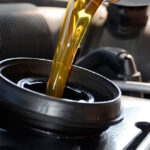Slide 1. Introduction.
The class develops what the EGR valve is, what functions it performs, and why it gives so many problems.
- EGR valve.
- How to clean the EGR valve.
Slide 3. The EGR valve.
The EGR valve is a part that almost all cars with combustion engines have and it is usually synonymous with problems.
This system began to be used in the 70's and became popular at the end of the 90's, when it was mandatory to install it due to the entry into force of the Euro 2 regulation in Europe, in 1996.
In essence, it is an anti-pollution component that serves to reduce nitrogen oxide-NOx emissions in both diesel and gasoline engines.
- Objective: to reduce emissions.
It is called EGR-Exhaust Gas Recirculation. And that is precisely the function of this part: to introduce part of the gases resulting from combustion into the engine so that they are not released into the atmosphere and are used in a new combustion phase. In this way, the mixture is less rich in oxygen and emissions of nitrogen oxides are reduced.
So, what EGR does is to recycle the gases coming out of the exhaust manifold and reintroduce them into the combustion chamber. How is this possible? Through a simple valve that connects the exhaust manifold to the intake duct; that valve is EGR.
In addition to helping to reduce NOx emissions, EGR speeds up engine warm-up, especially in diesel engines, which need more time to warm up.
Since the gases resulting from combustion are already hot, the mixture of clean air and these gases that enters the engine when EGR is open allows the block to warm up faster than it would with clean air alone.
It must be emphasized that the EGR valve is open because sometimes it remains closed and the mixing of air from the intake and exhaust manifolds does not occur. Normally the EGR valve opens when the engine is cold, at start-up, and when low power is demanded, i.e. when the engine is running at low load, e.g. on the highway.
The reason for this is simple: the colder the air entering the engine, the higher the efficiency. If that air is mixed with the hot air resulting from combustion, the performance is lower, so when the EGR is open, power delivery is not optimal because the air entering the combustion chamber has less oxygen.
Years ago, EGR valves were mechanical and now they are electronically controlled by an ECU that decides when they should open and close based on multiple parameters.
In addition, modern EGRs may have a small radiator to reduce the temperature of the exhaust gases returning to the intake and reduce NOx emissions even further, the lower the combustion temperature, the fewer the nitrogen oxides.
The reason combustion engine cars have an EGR valve is purely environmental. The problem is that this component often fails and EGR failures are not exactly cheap.
- What to do if the EGR fails.
It can fail because it stays open and that means that the air entering the engine is always mixed with the exhaust gases, resulting in loss of performance, more fuel consumption, possible jerks when accelerating and more smoke than necessary coming out of the exhaust.
If, on the other hand, the EGR valve remains closed, the engine will run well, even better because the air entering the combustion chamber is cleaner, but NOx emissions are higher than they should be. In short, the car pollutes more.
There are people who deliberately seek to block the EGR and plug it with a plate or override it electronically so that it always remains closed. Their aim is to make the engine perform better, but above all to avoid breakdowns: if the EGR does not work, it does not break down either.
Another EGR-related malfunction is carbon buildup. It is the most common and occurs especially in diesel engines, which are more prone to create carbon deposits. This dirt can accumulate in the EGR and block it, causing the problems we have mentioned if it stays open or an excess of gases if it stays closed.
In addition, if left open, carbon builds up not only in the EGR, but also in the intake, reducing the flow of air into the combustion chamber and causing a loss of performance, as happens with the arteries of the human body and cholesterol. If combustion is poorer, more carbon is produced, so it is a case of the fish that bites its own tail.
When a diesel car drives a lot in the city and the engine frequently rotates at a low engine speed, more carbon is produced, so diesel cars that do a lot of city driving and not much highway driving are more prone to have their EGR clogged.
The problem is that replacing a broken EGR with a new one is not cheap, on average about 500 euros, and in case of driving with a clogged EGR, the failure can be even worse and end up clogging other components, such as the particulate filter.
For this reason, it is recommended to decarbonize the car by driving outside the city and driving at a fast engine speed from time to time to eliminate all the accumulated dirt, causing the typical black smoke that can be seen when a car joins the highway or overtakes.
If there is no other choice, another alternative is to clean the EGR. It can be done manually, with a toothbrush, for example, but there are also ultrasonic machines that leave this part spotless. In any case, it is always necessary to remove it, with the labor cost that this entails. Of course, it is better to do this than to suffer a breakdown and have to change it.
With normal driving and proper maintenance, there should be no problems, especially in modern cars, since their EGRs are much more advanced than those of models from two decades ago.
Slide 4. How to clean the EGR valve.
- Why does it get dirty?.
The EGR valve helps reduce emissions of nitrogen oxides by recirculating a portion of the exhaust gases back into the engine. This process cools the combustion temperature, but it can also lead to the buildup of carbon and other debris, especially under conditions of low pressure and incomplete combustion.
- Symptoms of a dirty EGR valve.
- Engine shuddering and erratic operation.
- Increased fuel consumption.
- Dark exhaust smoke on acceleration.
- Reduced engine power, especially when starting.
- Increased pollutant emissions.
- How to clean the EGR valve without disassembling.
To clean the EGR valve without disassembling anything, these techniques can be used:
- High-speed driving.
A simple way to try to clean the EGR valve is to drive at high speed for several minutes. The increased temperature and gas flow can help burn off some of the accumulated soot.
- Heavy acceleration in high gears.
This technique can help clear minor blockages by forcing increased gas flow through the valve.
- Fuel additives.
Using specific engine-cleaning additives can help dissolve debris within the EGR system and other engine components.
- Use quality oils.
Much of the carbon that is expelled through the exhaust is generated by the combustion of the oil. Using cheap lubricants will increase the amount of carbon in the exhaust and shorten the life of the EGR.
- Cleaning of the EGR valve with decarbonizing products.
An effective and non-invasive method is the use of a hydrogen decarbonization treatment, which should be performed in a specialized workshop. This process breaks down soot and improves combustion.
- How to clean the EGR valve by disassembling it.
If the above methods are not effective, it may be necessary to disassemble the valve for further cleaning.
1. Locating and disassembling: Refer to the vehicle manual to locate the EGR valve. Carefully disconnect the connections and hoses and remove the valve with the proper tools.
2. Deep cleaning: Immerse the valve in gasoline or a specific cleaner for engine components. After several hours, use a brush to remove all soot and accumulated dirt.
3. Reinstallation: Before reinstalling the valve, check and, if necessary, replace the sealing gasket to prevent leaks. Reinstall the valve by following the steps in reverse order.
- EGR valve maintenance price.
Doing the cleaning yourself can be inexpensive, generally requiring an investment of 20 to 50 euros in cleaning products. However, professional services can cost between 100 and 150 euros. If the valve needs to be replaced, costs can increase to approximately 500 euros, including labor.
Keeping the EGR valve clean is essential for good performance and efficiency of the car's engine. Depending on the severity of the blockage, you can opt for cleaning methods without disassembly or, if necessary, perform a complete disassembly for a thorough cleaning.
Slide 5. Thank you for your time.
The class has developed what the EGR valve is, what functions it performs and why it gives so many problems, see you soon.
Download the audio




















